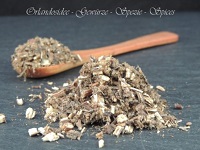
Mugwort cut
Artemisia vulgaris — peppery, lightly minty, herbaceous
Mugwort is a classic European cooking herb from the Asteraceae family. Its aroma is slightly hot and peppery with a gentle spearmint-like note and subtle bitterness that brings structure to rich roasts, gravies and hearty vegetables.
- Botany: Artemisia vulgaris • Family: Asteraceae
- Part used: leaves/tips, dried and cut
- Profile: savory herbaceous, peppery warmth, mild mint, restrained bitterness
- Best for: poultry & game roasts, gravies, potatoes, cabbage, mushrooms, stuffing
Aroma & Taste
Earthy-green with peppery lift and a cool, mint-leaning finish. A pinch adds backbone; too much can become assertively bitter—dose with care.
Culinary Uses
- Roasts: rub onto duck, goose or chicken with salt, garlic and lemon zest.
- Gravy & pan sauces: deglaze roast drippings and simmer with a small pinch; strain before serving.
- Vegetables: season potatoes, carrots, cabbage or mushrooms during roasting or braising.
- Stuffings & breads: mix into bread stuffings or rustic loaves for a savory, woodsy accent.
- Herb blends: combine with thyme and rosemary for robust rubs.
How to Use
- Bloom in fat: warm briefly in butter/olive oil (10–20 s) to release aroma.
- Add early for roasts/braises: withstands longer cooking; finish with a tiny pinch off-heat if desired.
- Crush to release: rub dried leaves between fingers before adding.
- Fresh ↔ dried guide: about 1 tsp dried ≈ 1 Tbsp fresh; start small and adjust.
Dosage & Kitchen Ratios
- Roast rubs: 1/2–1 tsp dried per 500 g (1.1 lb) meat.
- Gravy/sauce: 1/4–1/2 tsp per 1 l (4 cups) liquid; simmer and strain.
- Vegetables/stuffing: 1/2 tsp per 500 g veg or stuffing mix.
Pairings
Garlic, onion, lemon zest, black pepper, bay leaf, thyme, rosemary; with duck, goose, chicken, pork, potatoes, cabbage, carrots and mushrooms.
Ingredients & Allergens
Ingredients: Mugwort leaves (Artemisia vulgaris), dried and cut.
Allergens: none mandatory in EN labeling for this single ingredient.
Storage & Shelf Life
Store airtight, cool, dry and away from light. Best within 12–18 months. Reseal promptly after use.
Substitutes & Notes
Closest swaps: a light mix of thyme + a hint of sage (different but comparable strength). Mugwort is potent—use a conservative hand.
FAQ
What does mugwort taste like?
Savory herbaceous with peppery warmth, a mild mint-like edge and gentle bitterness.
How do I avoid bitterness?
Use sparingly, bloom in fat, and balance with citrus or a touch of sweetness in sauces.
Should I strain it from sauces?
For smooth gravies, yes—infuse and strain; for rustic dishes, leave finely crushed leaves in.
Merchant contact: Orlandosidee — Spice Shop (see site imprint for full company details). Email: info(at)orlandosidee.de



